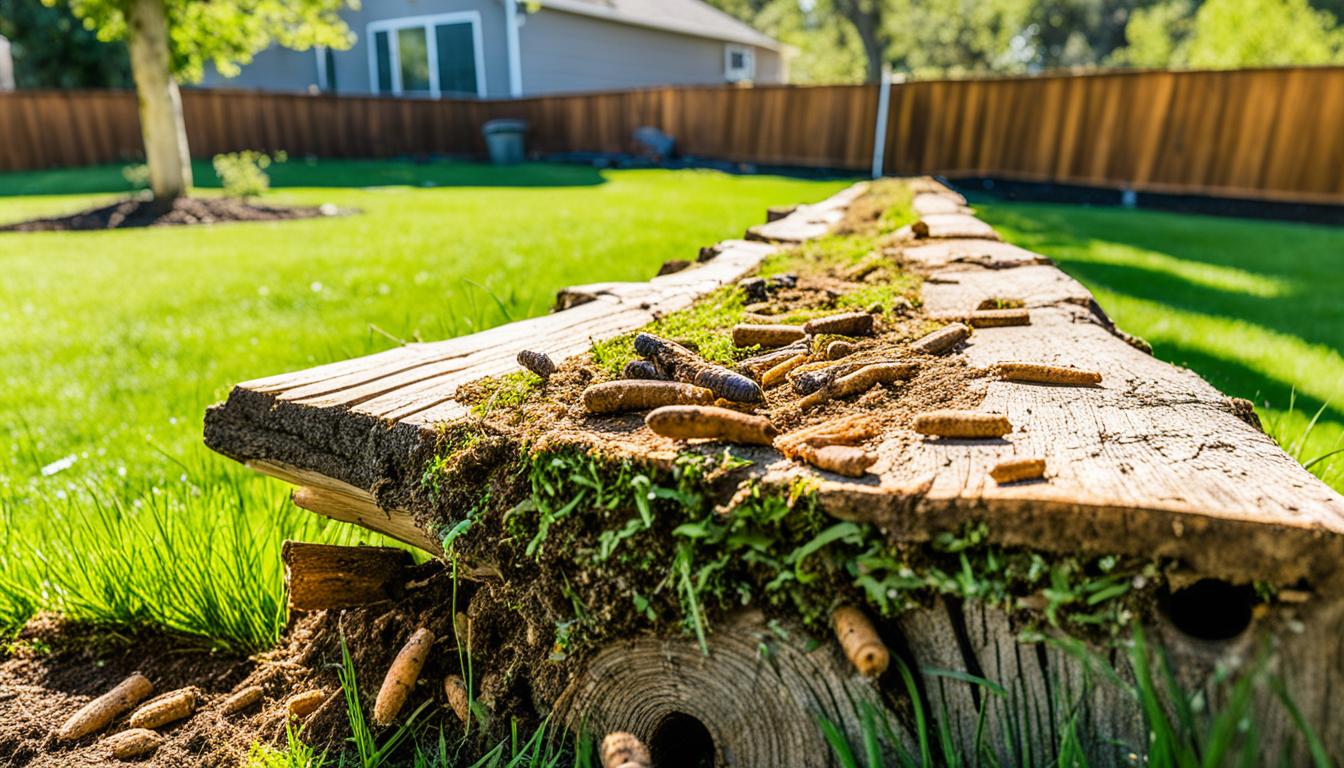When it comes to maintaining the health and safety of your home, there are many potential threats to be aware of. One pest that often strikes fear in the hearts of homeowners is the termite. These small insects have a reputation for causing serious damage to wooden structures, including houses and buildings. But should you be concerned if you spot termites in your yard? Are they an immediate threat to your property? Let’s delve into the world of termites and explore whether or not their presence should be cause for alarm.
Key Takeaways:
- Termites can cause significant damage to wooden structures, including homes and buildings.
- The presence of termites in your yard does not necessarily mean that your home is infested.
- It is important to monitor and address termite activity promptly to prevent potential infestations.
- Professional termite control services can help identify and eliminate termite infestations effectively.
- Implementing termite prevention measures can reduce the risk of future infestations.
Understanding the Risks: Why Termites in the Yard Can Be an Issue
Termites in your yard may seem harmless, but they can pose significant risks and dangers to your property. These destructive pests have a voracious appetite for wood and can cause extensive damage to the structural integrity of homes and buildings.
Termites feed on cellulose, the main component of wood, which means that no wooden structure is safe from their destructive tendencies. They can chew through wooden beams, foundations, floor joists, and even furniture, causing structural damage that can compromise the stability of your home.
The consequences of termite damage can be severe and costly to repair. In some cases, the damage may be so extensive that it becomes irreversible, requiring the complete reconstruction of affected areas. It is essential to address termite infestations promptly to minimize the risk of structural damage and wood destruction.
Not only can termites wreak havoc on your property, but they can also threaten your safety. If left unchecked, severe termite damage can lead to weakened structures that may collapse or become unsafe to inhabit. This can put you and your family at risk of injury or even worse.
By understanding the risks associated with termites in your yard, you can take proactive measures to protect your home and prevent further damage. Whether you have noticed signs of termite activity or want to safeguard your property from potential infestations, it is crucial to consult a professional pest control expert who can assess the situation and provide appropriate treatment options.
Should I be concerned if I see termites in my yard?
If you spot termites in your yard, it’s natural to wonder if you should be concerned about a potential infestation. While it’s always important to take pest sightings seriously, the presence of termites in your yard doesn’t necessarily mean that your home is in immediate danger. Understanding the signs of termite presence and activity can help you assess the situation more effectively.
When it comes to termites, their primary goal is to find a food source, which is typically wood. Seeing termites in your yard could indicate that they are searching for new food sources or establishing a satellite colony nearby. However, they may or may not have reached your home.
The key is to pay attention to the signs of termite activity. Some common signs of termite presence include:
- Wood damage, including hollow-sounding timber or weakened structures
- Mud tubes on exterior walls or foundations, used by termites as protective tunnels
- Discarded wings near windowsills, door frames, or other areas where termites may swarm
- Piles of termite droppings, which resemble small granules or pellets
- Cracked or bubbling paint, indicating termite damage beneath the surface
It’s important to note that termites are often subterranean, meaning they build their colonies underground and travel through mud tubes to reach their food sources. As a result, noticing termite activity in your yard does require attention, but it doesn’t automatically indicate a termite infestation in your home.
If you observe any of these signs or suspect termite activity, it’s advisable to consult with a professional pest control expert. They can conduct a thorough inspection and determine the extent of the termite presence, providing recommendations on the most appropriate course of action.
Termite Types and Their Habitats: Identifying Your Unwanted Guests
Termites come in various types, each with its own distinct habitat and behavior. Understanding these termite types is crucial for identifying the unwanted guests in your yard and home. In this section, we will explore the characteristics of two common termite types: subterranean termites and drywood termites.
1. Subterranean Termites:
Subterranean termites are known to be the most destructive termite species. They live in large underground colonies and build elaborate tunnel systems to access food sources. These termites are commonly found in areas with high moisture levels, as they require moist environments to survive. They are attracted to wood and cellulose materials and can cause significant damage to structures if left unchecked.
2. Drywood Termites:
Drywood termites, as their name suggests, do not require soil moisture to thrive. They inhabit dry wood and can infest furniture, wooden structures, and other dry materials. Unlike subterranean termites, they do not build extensive tunnel systems. Instead, they construct small galleries within the wood and live within these colonies. Drywood termites can be challenging to detect, as they do not create mud tubes or other visible signs of infestation.
To help you identify the termite type in your yard, it is essential to look for specific signs. Subterranean termites often leave mud tubes on walls and foundations, while drywood termites leave behind tiny piles of fecal pellets. If you suspect a termite infestation, it is advisable to consult a professional pest control service to accurately identify and address the issue.
| Termite Type | Habitat | Behavior | Wood Preferences |
|---|---|---|---|
| Subterranean Termites | Underground colonies | Build tunnel systems, require moisture | Wood and cellulose materials |
| Drywood Termites | Dry wood | Live within small galleries in the wood | Wood, furniture, dry materials |
Signs of Termite Presence: Warning Indicators in Your Yard
When it comes to termite infestations, early detection is key. By being aware of the signs of termite activity in your yard, you can take proactive measures to protect your home from potential damage. Here are the warning indicators to look out for:
- Termite mud tubes: These are small, narrow tubes made of soil and termite droppings. They serve as protected highways for termites to travel between their underground colonies and the wooden structures they feed on.
- Termite damage signs: Keep an eye out for any signs of damaged wood, such as hollowed-out or blistered surfaces. Termites eat through wood from the inside out, leaving behind thin layers or tunnels.
- Discarded wings: After reproductive termites, also known as termite swarmers, mate and establish new colonies, they shed their wings. Finding discarded wings around your yard can indicate the presence of swarmers nearby.
- Termite swarmers: Swarmers are winged termites that emerge from their nests to mate and start new colonies. Spotting swarmers around your yard, particularly in large numbers, suggests an active termite infestation.
If you come across any of these indicators, it’s crucial to take prompt action. Consult with a professional termite exterminator to assess the extent of the infestation and guide you through an effective treatment plan.
Common Mistakes in DIY Termite Control: What Not to Do
When faced with a termite infestation, homeowners often resort to DIY termite treatment methods in an attempt to save money. While it’s admirable to take matters into your own hands, it’s important to be aware of the common mistakes that can be made in DIY termite control. By avoiding these mistakes, you can increase your chances of effectively eliminating termites from your property and protecting your home.
One of the most common mistakes homeowners make is relying solely on DIY treatments without addressing the root cause of the infestation. DIY termite treatments, such as sprays or baits, may provide temporary relief, but they often fail to eliminate the entire termite colony. Without targeting the source of the infestation, termites can continue to cause damage to your home.
Another mistake is underestimating the extent of the infestation. Termites are experts at hiding, and what may seem like a small problem on the surface could actually indicate a much larger infestation within your home’s structure. DIY treatments may not be effective in eliminating a widespread termite infestation, and professional intervention may be necessary.
Using incorrect or ineffective products is another common mistake in DIY termite control. It’s essential to choose products that specifically target termites and are proven to be effective. Using generic or incorrect treatments can be a waste of time and money, allowing termites to continue damaging your property.
Additionally, improper application of termite control products can render them ineffective. Following the instructions provided with the products is crucial to ensure their proper usage. Failing to do so may not only result in ineffective termite removal but also pose risks to your health and safety.
Lastly, DIY termite control should not replace regular inspections and professional assistance. While DIY treatments can be a good temporary solution, it’s important to have your home regularly inspected by a professional pest control company. They have the expertise to identify and treat termite infestations effectively, providing long-term protection for your home.
By avoiding these common mistakes and seeking professional help when needed, you can ensure that your DIY termite control efforts are effective and successful in eliminating termite infestations. Remember, protecting your home from termites requires a comprehensive approach that addresses the root cause of the problem.
Gardening Practices that Discourage Termite Infestations
Creating a termite-resistant yard requires proactive gardening practices. By implementing these strategies, you can significantly reduce the risk of termite infestations and protect your home. Focus on three key areas: termite prevention, termite-resistant plants, and moisture control.
Termite Prevention
Preventing termites from entering your yard is the first line of defense. Regularly inspect the perimeter of your home for any cracks or gaps and seal them with caulk or weatherstripping. This will restrict termite access and make it more difficult for them to infiltrate your property. Additionally, consider installing a physical termite barrier, such as a stainless steel mesh, around the foundation of your home to create an impenetrable barrier against termites.
Termite-Resistant Plants
Choosing the right plants can play a crucial role in termite prevention. Opt for termite-resistant plants that are less appealing to these pests. Some examples of termite-resistant plants include lavender, marigold, rosemary, and catmint. These plants produce scents that naturally repel termites, making them a great addition to your landscape and garden.
Moisture Control
Moist environments attract termites, as they thrive in areas with high humidity. To minimize moisture levels in your yard, ensure proper drainage by grading the land away from your home’s foundation. Regularly clean your gutters to prevent water accumulation, and fix any leaky faucets or pipes promptly. Additionally, avoid overwatering your plants, as excessive moisture can create an inviting environment for termites.
| Gardening Practices | Effectiveness |
|---|---|
| Regularly inspect and seal cracks or gaps in the foundation. | High |
| Install a physical termite barrier around the foundation. | High |
| Choose termite-resistant plants for your garden. | Moderate |
| Maintain proper drainage to prevent excessive moisture. | High |
By implementing these gardening practices, you can create an environment that is less attractive to termites and reduce the risk of an infestation. However, it’s important to note that these measures may not guarantee complete termite prevention. If you suspect a termite infestation or need professional assistance, it’s recommended to seek the help of a licensed pest control expert.
Conclusion
After exploring the risks and signs of termites in your yard, it is clear that taking action to protect your home is crucial in preventing a potential infestation. By implementing effective termite control strategies, you can safeguard your property from these destructive pests.
One of the most important steps in termite control is early detection. Regularly inspecting your yard and home for signs of termite activity, such as mud tubes, damaged wood, or termite swarmers, can help you identify and address any issues before they escalate.
While there are various DIY termite control methods available, it is important to be cautious. Some DIY treatments can be ineffective or even exacerbate the infestation. To ensure effective termite removal, it is recommended to seek professional assistance. Experienced pest control professionals have the knowledge and expertise to effectively eliminate termites and protect your home.
Additionally, adopting gardening practices that discourage termite infestations can further enhance your termite control efforts. Choosing termite-resistant plants and maintaining proper moisture levels in your yard can make it less attractive to termites, reducing the risk of infestation.
By implementing these termite control strategies and seeking professional help when needed, you can take proactive steps to protect your home from termites. Don’t wait until it’s too late – start implementing these measures today to ensure your home remains termite-free for years to come.
FAQ
Should I be concerned if I see termites in my yard?
Yes, termite presence in your yard is a cause for concern. Termites can cause significant damage to wood structures, including homes and buildings. It is important to address termite infestations promptly to prevent further damage.
What are the risks associated with termite infestations?
Termite infestations can lead to structural damage and destruction of wood materials. This can weaken the integrity of your home and may result in costly repairs. Additionally, termites can also affect furniture, books, and other cellulose-containing materials.
How can I identify the presence of termites in my yard?
Signs of termite activity include mud tubes, damaged wood with a honeycomb-like appearance, discarded wings, and termite swarmers. If you notice any of these signs, it is important to take action and address the infestation promptly.
What are the different types of termites that can infest my yard?
There are various types of termites that can infest your yard and home, including subterranean termites and drywood termites. Subterranean termites build mud tubes to travel between their underground nests and food sources, while drywood termites infest dry wood without needing soil contact.
How can I prevent termite infestations in my yard?
To deter termites, you can select termite-resistant plants for your yard, maintain proper moisture levels by fixing leaks and preventing excessive water accumulation, and create a landscape that is less attractive to termites by keeping firewood and wooden debris away from your home.
What are some common mistakes to avoid when attempting DIY termite control?
DIY termite control methods can often be ineffective and may even worsen the infestation. Some common mistakes include using over-the-counter products without professional guidance, failing to address the root cause of the infestation, and not completely eliminating the entire termite colony. It is best to seek professional help for effective termite control.










